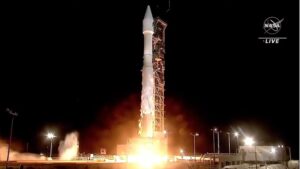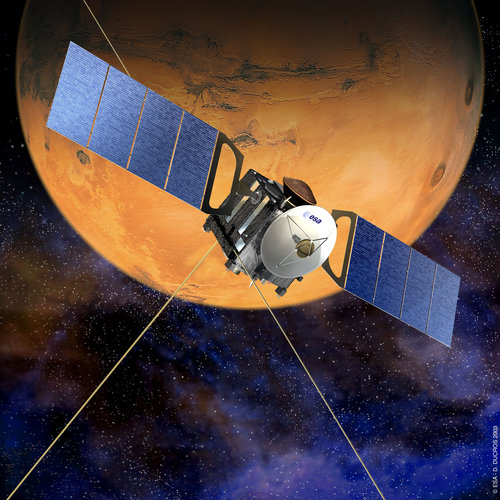Nicole postpones NASA Artemis I mission until Nov. 16
Thursday, 10 November 2022 11:35 NASA has decided to re-schedule its Artemis 1 mission launch to Nov. 16, "pending safe conditions for employees to return to work."
The space agency is monitoring Tropical Storm Nicole Wednesday morning as it approaches the eastern coast of Florida.
"Adjusting the target launch date will allow the workforce to tend to the needs of their families and homes, and provide sufficient
NASA has decided to re-schedule its Artemis 1 mission launch to Nov. 16, "pending safe conditions for employees to return to work."
The space agency is monitoring Tropical Storm Nicole Wednesday morning as it approaches the eastern coast of Florida.
"Adjusting the target launch date will allow the workforce to tend to the needs of their families and homes, and provide sufficient Rocket Lab announces launch window for inaugural Electron launch from Wallops Island
Thursday, 10 November 2022 11:35 Rocket Lab USA, Inc. (Nasdaq: RKLB) has announced it plans to launch its first Electron mission from Virginia during a launch window opening December 7 EST. The mission, named "Virginia is for Launch Lovers," will deploy satellites for leading radio frequency geospatial analytics provider HawkEye 360.
It will be Rocket Lab's first lift-off from Launch Complex 2 at Virginia Space's Mid-Atla
Rocket Lab USA, Inc. (Nasdaq: RKLB) has announced it plans to launch its first Electron mission from Virginia during a launch window opening December 7 EST. The mission, named "Virginia is for Launch Lovers," will deploy satellites for leading radio frequency geospatial analytics provider HawkEye 360.
It will be Rocket Lab's first lift-off from Launch Complex 2 at Virginia Space's Mid-Atla Splashdown is Just the Start for NASA Heat Shield Recovery Team
Thursday, 10 November 2022 11:35 After NASA's inflatable heat shield splashes down 500 miles off the coast of Hawaii, the Low-Earth Orbit Flight Test of an Inflatable Decelerator, or LOFTID, technology demonstration will be complete - but the mission's recovery team will still be hard at work.
LOFTID is scheduled to launch Nov. 10 aboard a United Launch Alliance (ULA) Atlas V as a secondary payload with National Oceanic a
After NASA's inflatable heat shield splashes down 500 miles off the coast of Hawaii, the Low-Earth Orbit Flight Test of an Inflatable Decelerator, or LOFTID, technology demonstration will be complete - but the mission's recovery team will still be hard at work.
LOFTID is scheduled to launch Nov. 10 aboard a United Launch Alliance (ULA) Atlas V as a secondary payload with National Oceanic a Nicole weakens to Tropical Storm, threatens NASA launch
Thursday, 10 November 2022 11:35 Tropical Storm Nicole slowed after making landfall in the US state of Florida, meteorologists said Thursday, with high winds raising concerns that a long-delayed NASA rocket launch could be disrupted.
The storm, a rare occurrence this late in the year, sparked mandatory evacuation orders just weeks after Florida was battered by Hurricane Ian.
But just an hour after Nicole made landfall a
Tropical Storm Nicole slowed after making landfall in the US state of Florida, meteorologists said Thursday, with high winds raising concerns that a long-delayed NASA rocket launch could be disrupted.
The storm, a rare occurrence this late in the year, sparked mandatory evacuation orders just weeks after Florida was battered by Hurricane Ian.
But just an hour after Nicole made landfall a SmartSat CRC and NASA team up to collaborate on astronaut emergency communications
Thursday, 10 November 2022 11:35 SmartSat Cooperative Research Centre, has announced a project agreement to further develop new Search and Rescue (SAR) beacon technologies with partner NASA.
Australia and the United States, as leaders in the field, have a long history of cooperation in Search and Rescue. In 2020 NASA and SmartSat announced a collaboration to advance satellite-based emergency communications and Search and
SmartSat Cooperative Research Centre, has announced a project agreement to further develop new Search and Rescue (SAR) beacon technologies with partner NASA.
Australia and the United States, as leaders in the field, have a long history of cooperation in Search and Rescue. In 2020 NASA and SmartSat announced a collaboration to advance satellite-based emergency communications and Search and S.S. Sally Ride delivers experiments to International Space Station
Thursday, 10 November 2022 11:35 The S.S. Sally Ride delivered experiments and other supplies to astronauts on the International Space Station Wednesday morning.
Crews completed the installation process shortly after 8 a.m. after astronauts on the ISS snagged the S.S. Sally Ride Cygnus spacecraft with its robotic arm earlier Wednesday, successfully bringing in some 8,200 pounds of scientific investigations and cargo on
The S.S. Sally Ride delivered experiments and other supplies to astronauts on the International Space Station Wednesday morning.
Crews completed the installation process shortly after 8 a.m. after astronauts on the ISS snagged the S.S. Sally Ride Cygnus spacecraft with its robotic arm earlier Wednesday, successfully bringing in some 8,200 pounds of scientific investigations and cargo on SES and Shevon to boost African mining connectivity
Thursday, 10 November 2022 11:35 A leading African mining company based in the DRC will be enjoying high-speed satellite-based connectivity services as part of a new agreement between Shevon and SES, the two companies announced today.
The two-year agreement will see Shevon provide for the first time SES's O3b Medium earth Orbit (MEO) high-throughput and low-latency connectivity services, enabling the DRC mining company to
A leading African mining company based in the DRC will be enjoying high-speed satellite-based connectivity services as part of a new agreement between Shevon and SES, the two companies announced today.
The two-year agreement will see Shevon provide for the first time SES's O3b Medium earth Orbit (MEO) high-throughput and low-latency connectivity services, enabling the DRC mining company to Rocket Lab to launch HawkEye 360's Cluster 6 satellites in December
Thursday, 10 November 2022 11:35 HawkEye 360 Inc., the world's leading commercial provider of space-based radio frequency (RF) data and analytics, today announced its Cluster 6 next-generation satellites is scheduled to launch during a 13-day window that opens on December 7 aboard the inaugural Rocket Lab Electron flight at Virginia Space's Mid-Atlantic Regional Spaceport within NASA's Wallops Flight Facility. The satellites wi
HawkEye 360 Inc., the world's leading commercial provider of space-based radio frequency (RF) data and analytics, today announced its Cluster 6 next-generation satellites is scheduled to launch during a 13-day window that opens on December 7 aboard the inaugural Rocket Lab Electron flight at Virginia Space's Mid-Atlantic Regional Spaceport within NASA's Wallops Flight Facility. The satellites wi Arianespace to launch EAGLE-1 for Europe's Quantum Cryptography program
Thursday, 10 November 2022 11:35 The EAGLE-1 satellite, which will support the end-to-end secure Quantum Key Distribution (QKD) system for Europe, will be launched for SES by Arianespace on a Vega C rocket from French Guiana as early as Q4 2024.
The satellite will be placed into Low Earth Orbit (LEO). The EAGLE-1 project comprising satellite and ground infrastructure, is developed by SES and its consortium of 20 European
The EAGLE-1 satellite, which will support the end-to-end secure Quantum Key Distribution (QKD) system for Europe, will be launched for SES by Arianespace on a Vega C rocket from French Guiana as early as Q4 2024.
The satellite will be placed into Low Earth Orbit (LEO). The EAGLE-1 project comprising satellite and ground infrastructure, is developed by SES and its consortium of 20 European Ground Survey Datasets Released to Validate Satellite-based Remote Sensing Data
Thursday, 10 November 2022 11:35 Recently, the Aerospace Information Research Institute (AIR) with the Chinese Academy of Sciences (CAS) has released the second batch of ground survey datasets through its Common Application support Platform for Land Observation Satellite (CAPLOS), which can be downloaded for free by the users who registered on the website: http://caplos.aircas.ac.cn
Based on the datasets released earlier,
Recently, the Aerospace Information Research Institute (AIR) with the Chinese Academy of Sciences (CAS) has released the second batch of ground survey datasets through its Common Application support Platform for Land Observation Satellite (CAPLOS), which can be downloaded for free by the users who registered on the website: http://caplos.aircas.ac.cn
Based on the datasets released earlier, Atlas 5 launches weather satellite, reentry tech demo mission
Thursday, 10 November 2022 10:37
An Atlas 5 successfully launched a polar-orbiting weather satellite and a reentry technology demonstrator on the final flight of the vehicle from California.
The post Atlas 5 launches weather satellite, reentry tech demo mission appeared first on SpaceNews.
Food science research could help astronauts eat well on future Mars missions
Thursday, 10 November 2022 07:27
If space is the final frontier, it's food that will get us there in good shape, and UBC researchers are making sure that our food will be up to the task.
Dr. John Frostad, an assistant professor in chemical and biological engineering who studies the science of food, leads a team that is creating new ways of encapsulating omega-3 fatty acids so that they can go the distance.
Omega-3 is essential to mental sharpness. Even a couple of days without omega-3 in our diets may dull our brains and have us feeling less than our best. However, our bodies cannot produce it naturally so we must find it in the foods we eat, such as fish, flaxseed, or often by taking supplements.
"For astronauts and others on space missions, the difficult part is ensuring that omega-3 stays fresh and viable in whatever form—capsules or liquid—it is stored in," explains Dr. Frostad.
"The shelf life of most omega-3 capsules is around two years, but space missions can go for longer than that and they must be self-sufficient. You can't do a grocery run every couple of months.
Rocket Lab wins $14 million in contracts to supply hardware for U.S. military satellites
Wednesday, 09 November 2022 21:21
Rocket Lab USA won two contracts worth $14 million to provide separation systems for Space Development Agency satellites.
The post Rocket Lab wins $14 million in contracts to supply hardware for U.S.
HawkEye 360 delivers satellites for Rocket Lab’s first launch from U.S. soil
Wednesday, 09 November 2022 20:17
HawkEye 360's next three satellites will launch as early as December 7 on a Rocket Lab Electron rocket from a Virginia spaceport.
The post HawkEye 360 delivers satellites for Rocket Lab’s first launch from U.S.


